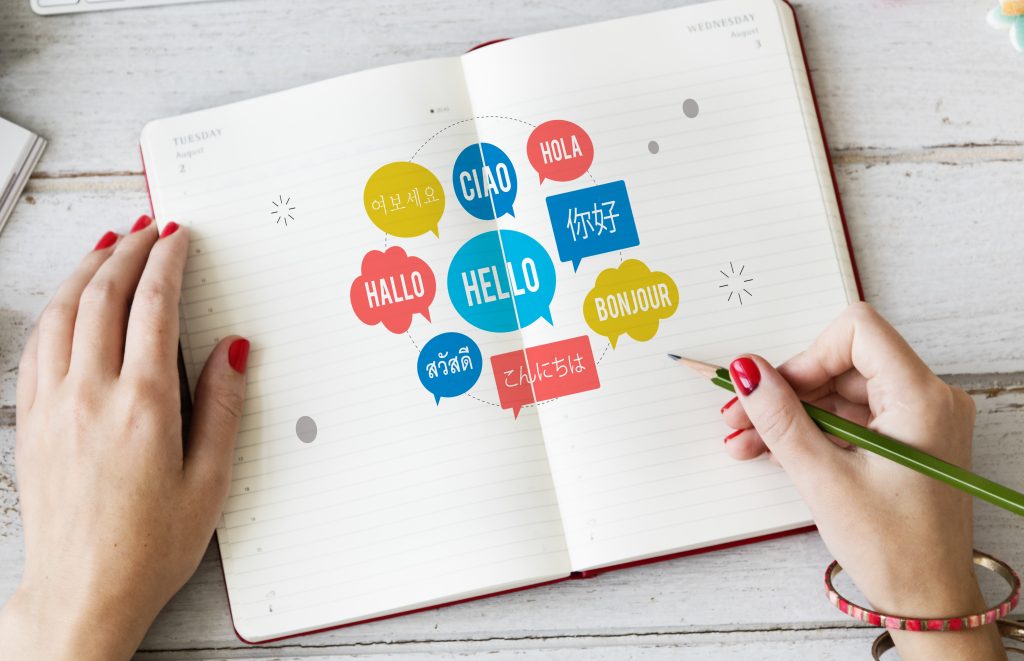
For decades, the language barrier has been a dilemma that has overshadowed the bright future of the education and learning sector. However, the tables have turned as there are numerous ways to help mankind climb over this barrier and reach their ultimate goal – seeking knowledge.
Did you know the United States received applications from a million international students between 2022 and 2023? The United States has been a global leader and a top priority for students when it comes to receiving higher education abroad. However, most of the students come from Asian or Arabian countries and are non-native speakers.
Therefore, to cater to the needs and provide a smooth onboarding, the Education Dept in the United States has started to hire bilingual and multi-lingual teachers to help the students learn English so that they can excel in their studies without language restrictions.
This was one way our education system showed language barriers are not entirely barriers if you choose to take charge of the situation and make necessary amends to fill the gap, like hiring bilingual and multi-lingual teachers.
Today, translation and interpretation are some of the most prominent ways people use to overcome language restrictions in the education sector. Here is the importance of translation in education and how document translation contributes to your education and learning.
The Benefits Of Translation Services In Education and Learning

According to UNESCO, around 2.2 million books are published each year in the world. But do you think all of these books are accessible in every language? No, right? In order to make knowledge accessible to mankind, translations came into being. Let’s have a look at how these services help you with your learning journey.
Improves Accessibility And Inclusivity
E-learning is a way that helps people get education from anywhere in the world, at any time. This way of learning has made education more accessible and inclusive. How does e-learning facilitate people with different cultural and language backgrounds? With the help of e-learning, document translation becomes a method that makes educational content available in almost every language found on Earth. Why are innovations like e-learning a big thing?
E-learning is hyped because it eradicates the language barrier and makes education more inclusive and accessible. A language barrier feels like you are solving a puzzle that can change your life, and the clues are locked in the treasure box. Translation service is the key to helping you open the doors of this treasure box.
By translating educational materials, presentations, and lectures into various languages, the translation industry bridges the gap and ensures equal access to information for all students, regardless of their native language. This is particularly beneficial for international students, students with limited English proficiency, educators, etc. To further elaborate on the importance of translation in education accessibility and inclusivity, read on:
- International students can access the course materials and lectures in their native languages. This will help them understand complex concepts more easily and participate actively in class discussions.
- For example, students who are not good at English can use translated educational content to get help understanding the curriculum. This will make them confident in their academic performance.
- Teachers or educators use translated resources to cater to diverse student needs, creating a more inclusive educational institute where every student feels valued and supported.
Makes The Topic Understandable And Engaging
Just imagine reading the ingredients of a recipe in Chinese; there are symbols for the items used, but you are unable to understand their quantities. How would you feel?
This is how learning in a foreign language can feel to students with a different mother tongue. Therefore, translations and interpretations come into action and make the educational material understandable and engaging for them.
When students have access to information in their native language, they comprehend difficult concepts more easily. They go beyond basic comprehension and truly understand the meaning and intent behind the learning material.
At the same time, when a concept is clear to them, they will explore it further to feed their curiosity. The language barrier is a common reason for students not finding their education engaging. This might discourage a student from continuing their education, and they might even leave it in the middle. A survey related to the reasons behind school dropouts shows that 55% of students left their education because they didn’t find their preferred language.
A student who struggles with language cannot participate in class like others. They will not be able to participate actively in discussions, ask insightful questions, or seek further knowledge.
A translation service helps students to avoid language restrictions and engage meaningfully with the learning process. This will turn these passive learners into active participants!
Promotes Cultural Diversity
Books have been promoting cultures for centuries. What would have happened if the ancient books were not translated into modern languages? We would have zero clue of what the world has gone through in the past, and we wouldn’t be able to understand the different types of cultures.
Translation has acted as a bridge between us and history and allowed us to know more about the geography, culture, and diversity of the past. Don’t you like to be Sherlock Holmes and decipher what is written in those yellow manuscripts?
Well, students come with the same curiosity to educational institutions. By providing access to translated materials, these institutions expose students to different perspectives and cultural viewpoints.
This exposure is important for avoiding cultural biases, promoting empathy and appreciation, and making the learning experience more enjoyable. How do translations help in accepting cultural diversity?
- By learning about different cultures through translated materials, students can challenge their own assumptions and develop a more suitable perception of the world.
- They will involve themselves with translated literature, historical accounts, or cultural narratives from different backgrounds. This will instill empathy and appreciation in them for different customs, traditions, and ways of life.
- When you have translated materials in your curriculum, you will have a more holistic and culturally rich learning experience. Students can see their studies in a broader context, appreciating the interconnectedness of the world and the value of diverse perspectives.
Preparing Students for a Globalized World
As we know, everything is about technology, and cross-border collaboration and communication have become very common. That’s why translation skills have become a valuable asset to gel with the people around. In the education sector, translation service providers help students understand globalization.
Translations help the students with communication and knowledge exchange. They understand words said in the communication and are able to respond accordingly. When they are able to understand the translated material, their interest in the topic increases. They become more curious and more interested in their studies.
Their piqued interest and curiosity opens doors to new opportunities globally and also improves cognitive skills and cultural understanding.
Besides this, students can also use translated material as a resource in their language-learning process. They can compare the translated materials to the original text. This will help them gradually build their vocabulary, grasp sentence structures, and develop their own translation skills.
The Types of Translation Services in Education
Language barriers can hinder a student’s ability to reach their full potential. Thankfully, a wide range of educational translations exist to bridge the gap and ensure everyone has equal access to knowledge. Let’s explain further about the different types of services available:
No. 1. Document Translation
This is the most common type and the most fundamental service that involves translating educational materials like textbooks, course syllabi, handouts, assignments, and library resources into the target language.
The Benefits:
- This increases accessibility for students with limited proficiency in the primary language of instruction.
- It will improve comprehension of complex concepts and learning objectives.
- Enhanced engagement with the learning materials, leading to better academic performance.
- For example, translating science textbooks into Spanish for a growing Hispanic student population or converting English-language math worksheets into Arabic for students from the Middle East.
No. 2. Real-Time Interpretation
In real-time interpretation, the service provides qualified interpreters to facilitate communication during live educational events. This can include lectures, classroom discussions, meetings with parents or advisors, and school presentations. Interpreters can work on-site or virtually, depending on the situation.
The Benefits
- In real-time interpretation, the students get clear and accurate communication between educators and students with different native languages.
- This will help with active participation in class discussions and real-time clarification of doubts.
- It will further promote a more inclusive learning environment where all voices are heard and valued.
No. 3. Subtitling and Captioning
This is also an amazing job that benefits the students in different ways. This service involves adding subtitles or captions to educational videos, lectures, online courses, and other multimedia content. Subtitles are typically translated into the target language, while captions provide text descriptions of the audio content, including speaker identification and sound effects.
The Benefits Of Subtitles and Captions
- Subtitles and captions are best for people with disability or people who have poor proficiency in the language because it enhance accessibility for deaf and hard-of-hearing students, ensuring they can fully grasp the audio content.
- Allows students to revisit key points from lectures or video materials at their own pace.
- Provides additional context and support for students who are still developing their language skills.
- Let’s say subtitling a science documentary in French for a bilingual classroom or captioning a historical lecture series in English for students with hearing impairments.
No. 4. E-Learning Localization:
This specialized service goes beyond simple translation by adapting entire e-learning platforms and online courses for a specific target audience. This may involve cultural sensitivity checks, adapting graphics and user interfaces, and ensuring compatibility with local technologies.
The Benefits:
- This type of translation creates an easy and culturally relevant learning experience for international students accessing online courses.
- It is known for Increasing engagement and motivation by presenting the content in a familiar context.
- This will further expand the reach of educational institutions to a global audience.
Overcoming Language Barriers in Education

As we have already mentioned, there are multiple ways translation and interpretation help us in education and learning. Here, we will focus entirely on how they help us overcome language barriers.
One effective approach to combat language barriers in education involves hiring bilingual and multi-lingual teachers. These educators possess the unique ability to facilitate communication and understanding between the students and the educational institute.
They can directly translate complex concepts and instructions into students’ native languages. They make sure that everyone is on the same page and can actively participate in class.
On the other hand, a translation service provider understands the students’ cultural background and helps the teacher alter their teaching methods so that the students feel included.
For students, having a teacher who speaks their language can be incredibly helpful. Multi-lingual teachers will help them feel more confident and comfortable participating in class and expressing themselves freely.
Conclusion
Language barriers can pose numerous challenges in the education sector. However, as we’ve seen, solutions like hiring multi-lingual teachers and, more broadly, we have translation service providers that offer tools to avoid these gaps help learners and even explain the importance of translation in education.
When choosing an educational translator, consider factors like the type of content, the target audience, the delivery method (live or recorded), and your budget. TranslateSwift is one of the best translation companies with experienced translators who specialize in educational content and are familiar with the relevant terminology.
By using our educational translation assistance, institutions can order translations that create a truly inclusive learning environment where language is no longer a barrier to knowledge and success.
FAQs
Why Is A Translation Service Important In Libraries?
Libraries offer a wealth of knowledge, but language barriers can limit access. Translations bridge the gap by making resources available in various languages, promoting inclusivity, and enriching learning for diverse communities.
What Is The Importance Of Education Translation?
Translations ensure equal access to education for all, regardless of native language. They improve understanding, engagement, and cultural awareness while preparing students for the interconnected world through essential skills and global perspectives.
What Is Language In Inclusive Education?
Inclusive education uses clear language visuals and promotes multilingualism to support diverse learners. The translations helps to ensure accessibility for all students.
What Is The Role Of Translation In Academic Studies?
Translation facilitates access to research materials, enables collaboration across cultures, and develops critical thinking and communication skills. Moreover, it helps with cultural awareness and empathy for diverse viewpoints.
What Do Translators Do For Education?
Translations break down language barriers and promote inclusivity in education. They enhance learning outcomes and cultural understanding while preparing students for success in a globalized world.










